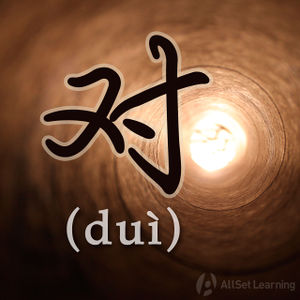Difference between revisions of "Using "dui" with verbs"
(→Books) |
|||
| Line 30: | Line 30: | ||
</div> | </div> | ||
| − | 对 is also used in | + | 对 is also used in such structures as: 对……来说 ("for... [a person]") ,对...感兴趣 ("to be interested in...") as well as 对···的印象(”the impression on the object“) |
== 对……来说 == | == 对……来说 == | ||
| Line 67: | Line 67: | ||
* 谁 <em>对</em> <strong>英语</strong> 很 感兴趣?<span class="trans">Who is interested in English?</span> | * 谁 <em>对</em> <strong>英语</strong> 很 感兴趣?<span class="trans">Who is interested in English?</span> | ||
* 你 好像 <em>对</em> <strong>她</strong> 不太 感兴趣。<span class="trans">You don't seem very interested in her.</span> | * 你 好像 <em>对</em> <strong>她</strong> 不太 感兴趣。<span class="trans">You don't seem very interested in her.</span> | ||
| + | |||
| + | </div> | ||
| + | |||
| + | == 对···的印象 == | ||
| + | |||
| + | This basically means "the impression on what you saw or what you know." | ||
| + | |||
| + | The pattern is: | ||
| + | |||
| + | <div class="jiegou"> | ||
| + | |||
| + | 对 + Object + 的印象 | ||
| + | |||
| + | <div> | ||
| + | |||
| + | <div class="liju"> | ||
| + | |||
| + | * 你来上海半年了,<em>对</em> <strong>这个城市</strong> 的印象怎么?<span class="trans">What's your impression on this city?</span> | ||
</div> | </div> | ||
Revision as of 10:05, 22 August 2013
-
Level
-
Similar to
-
Used for
-
Keywords
When using 对 (duì) as a preposition, it is used to indicate "to" or "towards" a object or target. As with all prepositions, some care should be taken when using this particle, as usage of 对 doesn't always totally "make sense" or correspond to English at all.
Contents
Basic Structure
The structure is basically:
对 + Object + Verb Phrase
Note that you shouldn't be plugging in just any old verb here. Certain verbs are often used with 对, and some even need 对 if you want to add an object (like 感兴趣, explained below).
Examples
Here are some examples:
- 他 对 我 笑。He laughs at me.
- 我 要 对 你 负责。I am going to be responsible for you.
- 她 对 我 很 客气。She was very polite to me.
- 你 为什么 对 我 有 意见 ?Why do you dislike me?
- 我 对 西安 不 熟悉。I am not familiar with Xi'an.
- 抽烟 对 健康 有害。Smoking is bad for your health.
对 is also used in such structures as: 对……来说 ("for... [a person]") ,对...感兴趣 ("to be interested in...") as well as 对···的印象(”the impression on the object“)
对……来说
This essentially means "for... (a person)." It's for making a statement from a certain person's point of view.
The pattern is:
对 + Person + 来说
- 川菜 对 我 来说 太 辣 了。To me, Szechuan food is too spicy.
- 对 她 来说 英语 很 容易。She thinks English is easy.
- 对 我 来说 书法 很 有意思。I think calligraphy is very interesting.
对……感兴趣
In English was say "to be interested in something." In Chinese, the pattern is:
对 + Object + 感兴趣
- 我 对 书法 感 兴趣。I am interested in calligraphy.
- 谁 对 英语 很 感兴趣?Who is interested in English?
- 你 好像 对 她 不太 感兴趣。You don't seem very interested in her.
对···的印象
This basically means "the impression on what you saw or what you know."
The pattern is:
对 + Object + 的印象
- 你来上海半年了,对 这个城市 的印象怎么?What's your impression on this city?
See also
Sources and further reading
Books
- Integrated Chinese: Level 1, Part 2 (3rd ed) (p. 153) →buy
- Integrated Chinese: Level 2, Part 1 (p. 151) →buy
- Modern Mandarin Chinese Grammar: A Practical Guide (pp. 84, 88) →buy
- Boya Chinese Elementary Starter 1 (博雅汉语初经起步篇) (pp. 198) →buy
- Chinese Grammar - Broken down into 100 items - Basic and Intermediate Levels (汉语语法百项讲练 - 初中级) (pp. 313) →buy
- 卓越汉语-公司实战篇 (pp. 11-2, 134) →buy



